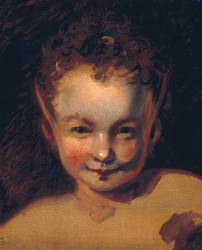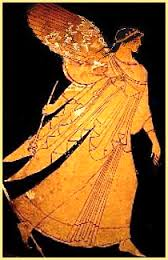
An Irish Pooka
The pre-Celtic deity known as the pooka, phooka, phouca, pooke, or puca and puka is a mischievous shape-shifting goblin that can appear as a horse, an ass or ghostly black dog. These creatures are ghost-like spirits of Irish cultural and folkloric origin (Koch, 2006). These creatures have parallel forms and words in many ancient cultures and languages with a devilish ancestry (Edwards, 1974). In the English medieval folklore tradition the pooka correlates with a demonic creature that is half-animal and of devilish appearance with horns, tail and cloven hoofs.
The pooka or puca is an ambivalent creature in the sense that they are considered as either beneficent, or menacing, wicked minded bad things with a black appearance (Keightley, 1858). In other words they either hinder or help, bring either bad or good fortune, in the rural or coastal communities where they live. Nonetheless the Irish puca “…is an odd mixture of merriment and malignity (Joyce, 1871). However, the pooka is the nastier and less friendly than the puca. As shape-shifters they are always dark in appearance whatever form they assume, whether black horse, goat, rabbit, goblin or dog. One certainty of the pooka is that they are always black hence the description “…as black as a pooka.” (Edwards, 1974), which in Irish translates as “…condub leis an bpuca.” Another scholar described the pookas as “…black featured fellows mounted on good horses; and are horse dealers.” (Wendz, 1988).
The pooka or phooka in Britain, like the Irish puca or the pwca of Wales, was a unique individual yet capable of appearing in many guises in as many different places.” (Edwards, 1974). The pwca in Wales was also a mischievous spirit who, because he tended to lead travellers astray, resembled the Will-o-the-wisp. In this respect the pwca and the Irish pooca appear as hobgoblins in Cornish folklore as the bucca, also identified as the ‘black spirit’ or bucca-dhu or bucca-boo. In addition the ‘white spirit’ was the bucca-gwidden or bucca-gwidder (McKillop, 1998). The bucca was not a fairy but indeed the remnant of an ancient deity whereas Puck was just a pisky. The bucca or buccaboo is connected to the Slavonic language through the word Bog meaning god. This in turn was equivalent to the Black God known as Czernobog. In some respects the word sprite Buckle suggests the bogle of Scotland.
Counterparts exist throughout the Celtic countries of north western Europe. In the Channel Islands there are the fairies of the ancient stones called the pouque. In reference to these ancient cromlechs, which in Guernesiais and Jerrais, are called pouquelee or pouquelays , corresponding terms are found in Brittany as policans (Price, 1830; Loth, 1894). Another equivalent is the buggane found in the folklore of Cornwall. A black and prankish practical joking sprite, and an adept at shape-shifting, who has been linked to the Irish pooca, the Scottish Gaelic Bocan, as well as the Manx cabbyl-ushtey. In addition the glashtyn of the Isle of Man had human form with the ears of a horse (McKillop, 1998).
Eventually the pagan pooka of Old England was identified with the devil of Christian belief, the Middle English pook and pooke became to be seen as sprites or goblins. From being an evil demon the pooka eventually “…became more closely assimilated with hobgoblins and shared their essential ambiguity.” (Edwards, 1974). In the folklore of Europe these goblins retained linguistically the original meaning of deil or evil malignant spirit. The puca remains in Irish and Old English alongside the puki of Old Norse. In Swedish there survives the puke with the Danes preserving the puge. Low German has its puks. In the Baltic region there remain the pukis of Lithuania and Latvia.
Mischievous ‘sweet puck’ or ‘sweet peace’ in English folklore is a somewhat nebulous creature. As a type of woodland sprite or fairy he has many aspects about him of a hobgoblin or Robin Goodfellow. His name means ‘unsettled’ and he can be compared to the Frisian puk, the Icelandic puki, and the pucel or poucel of Old English.

Robin Goodfellow Puck (1787-90). John Henry Fuseli.
Puck was originally a malicious English household goblin or ‘hob’, and who has been compared to the Brownie and Robin Goodfellow. Puck was thought of as a lusty nature fairy who personified the spirit of the land. In this role he was often portrayed as a cloven-hoofed Pan-like sprite with small horns. Renowned as shape-shifting prankster whose favourite delight is to mislead travellers as a type of Will-o-the-wisp. This trait of his employs the lights and echoes in misty woodlands at night-time and thus recognised as the merry wanderer of the night (Joyce, 1871). In this guise Puck resembles the Witte Wieven of Holland, the Weisse Frauen of Germany, and the Dames Blanches of France – all ‘White Ladies’. In one German form he is called Puck-hairy or Pickelharing.

Puck (1789). Sir Joshua Reynolds.
As a household spirit Puck carried out helpful tasks such as needlework, milk churning and other useful chores. For these labours he expected and liked small gifts, treats and milk. Nonetheless, the puck enjoys pranks and playing practical jokes and thus performs as a fairy jester, being known as a poake in Worstershire and the pixy in Cornwall.
The question sometimes arises concerning the German or Scandinavian origin of Puck and his transmission to Britain. Tradition in the Baltic region and Germany do resemble each other with aitvaras and kaukus in Lithuania, and fulihand and pisuhand in Estonia. The German association derives from puks in Schleswig Holstein and Mecklenburg. It is obvious across Europe that a variety of analogous puck figures exist, excluding the related Brownie of Scotland and the Kobold or Knecht Ruprecht in Germany, and Nisse Godreng in Scandinavia. William Shakespeare used Puck as a generic name for an elf, who appears as the fairy hero in A Midsummer Night’s Dream, so for Shakespeare Puck was the “…concentrated essence of elfdom…” (Wheatley, 1916). Puck was not created or invented by Shakespeare, the Robin Goodfellow, alias the Pooka, sometime hobgoblin or brownie – he “…simply annexed him out of current superstition…” (Green, 1962) by making him into a trickster spirit.
References and Sources Consulted
Briggs, K. 1976). A Dictionary of Fairies. Lane, London.
Briggs, K. (1977). Anatomy of Puck. Arno, New York.
Edwards, G. (1989). Hobgoblin and Sweet Puck. Geoffrey Bles, London.
Green. R. L. (1962). Shakespeare and the Fairies. Folklore. 73 (2). Summer.
Joyce, P. N. (1871). The Origin and History of Irish Names of Places. Dublin.
Kock, J. (2006). Encyclopaedia of Celtic Culture. ABC-Clio. USA.
Loth, J. (1894). Le Nain de Kerhuiton. Annales de Bretagne. 10.
McKillop, J. (1998). Dictionary of Celtic Mythology. OUP, Oxford.
Price, P. (1830). A Tour through Brittany. Cambrian Quarterly Magazine and Celtic repertory. 2 (23-43).
Wheatley, H. B. (1916). The Folklore of Shakespeare. Folklore. 27 (4). December, 31.












